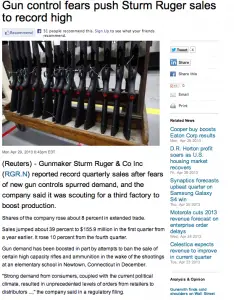It was a subtle thing. But a false number in a Reuters report that was published Monday night may have caused Sturm, Ruger shares (RGR on the New York Stock Exchange) to soar in aftermarket trading — only to deflate when the error was corrected at midmorning today, long after the market opened.
 The initial version of the story was very different both in structure and in detail from the corrected version. But the key problem was these lines (which were not juxtaposed in the orginal, but had non-pertinent information in between them). The first story was timestamped “Mon Apr 29, 2013 6:43pm EDT”:
The initial version of the story was very different both in structure and in detail from the corrected version. But the key problem was these lines (which were not juxtaposed in the orginal, but had non-pertinent information in between them). The first story was timestamped “Mon Apr 29, 2013 6:43pm EDT”:
Net income rose to $23.7 million, or $1.20 per share, in the quarter ended March 30, from $15.5 million, or 79 cents per share, a year ago.
Analysts on average expected a profit of $1.01 per share on revenue of $112.3 million, according to Thomson Reuters I/B/E/S.
The first line, above, was correct; the second, not. The corrected version led off with the correction, inserted a series of bullet points (interjecting another error), and corrected those analyst expectation numbers. This story was timestamped “Tue Apr 30, 2013 10:11am EDT”:
Net income rose to $23.7 million, or $1.20 per share, in the quarter ended March 30, from $15.5 million, or 79 cents per share, a year ago.
Analysts on average expected a profit of $1.01 per share on revenue of $131.7 million, according to Thomson Reuters I/B/E/S.
The irony is that the correction didn’t change the profit expectation, the really important thing, but the revenue prediction. Current revenues were stated correctly in both stories: $155.9 million. Using the correct prediction ($131.7m), though, made the revenue bump over expectations an excellent 18%, rather that the erroneous prediction’s ($112.3) astronomical 39%.
The significance of using the correct the analyst expectation is this: the market runs on information. It is generally assumed by market participants and analysts that it is an efficient market, and that all current information, including the state of current expert expectations, is priced in. A major divergence from analyst estimates means that the expert expectations were not priced correctly, and usually produces movement in the stock.
The Ruger filings and this story drove the stock from $49.05 at closing to as high as $52.34, a jump of 7%. Profit taking — and the correction — dropped the stock back to $50.30 by midday; by 1300 (time of this report) the solid fundamentals seemed to be sinking in, as the quote had risen to $51.37. But the reasons behind the fluctuation are uncertain; it’s very difficult to tease out the degree to which each factor drove the stock up and down, and it could close higher — or lower.

The Gun Wire was one of many innocent aggregators to pick up the early, misleading Reuters Ruger story.
The erroneous Reuters Ruger story was featured at Google News, by financial news sites such as Yahoo Finance’s Ruger page, and by the influential gun-news aggregator The Gun Wire.
The correct information about Ruger was always available in Ruger’s April 29 SEC filings, but few people other than investment analysts read these filings, the 8-K (Results of Operations and Financial Condition) and 10-Q (Quarterly Report) forms. But the error came in information from outside the company’s release: analyst estimates collected by Reuters themselves.
An interesting fact in the press releases accompanying the reports that Reuters chose not to highlight was that over half a million Ruger firearms were sold by Ruger distributors to retailers in the first quarter of calendar 2013. (514,200 to be pedantic; Ruger doesn’t track sales to individuals). They also didn’t mention Ruger’s backlog of 9 months’ production, 1.5 million guns on order from Ruger distributors, who are not stockpiling the guns — they’re being moved right along into retail channels.
An interesting fact that Ruger did mention in the press release, and Reuters and other picked up, is that Ruger says that 35% of its sales are new products, including the LC380 and SR45 pistols which began shipping in Q1 (perhaps also the 10/22 takedown, but they don’t mention that). This demand for novel products hints that Ruger’s growth isn’t just because of the current superheated buying climate.
How did the error happen? The Reuters reporter mostly likely made a simple error — easy to do when you’re juggling large quantities of soulless numbers, particularly when you’re doing it in a second language (the reporters and editors on the original story were in India). That’s much more likely than any kind of subtle pump and dump scheme — certainly the sellers at opening, when the stock was bubbled-up at 52 plus, did well. But the stockholders who hung on to RGR may be bigger winners in the long term. The fundamentals of the firm remain solid, and even when the current tsunami of gun-control hysteria recedes, as it must, it will leave behind hundreds of thousands of new gun owners and shooters created in these last few months, and hundreds of thousands of “dormant” ones who reentered the firearms market recently.
The correction itself was done properly, with a highly visible comment at the head of the story explaining exactly what was corrected, and what the erroneous information had been. But the report was more extensively rewritten than the correction suggested. (It also introduced a new error — either the 7% or 8% stock increase claim can be true, but not both!) Maybe a couple of reporters need to be transferred to the fashion beat?

Kevin was a former Special Forces weapons man (MOS 18B, before the 18 series, 11B with Skill Qualification Indicator of S). His focus was on weapons: their history, effects and employment. He started WeaponsMan.com in 2011 and operated it until he passed away in 2017. His work is being preserved here at the request of his family.
